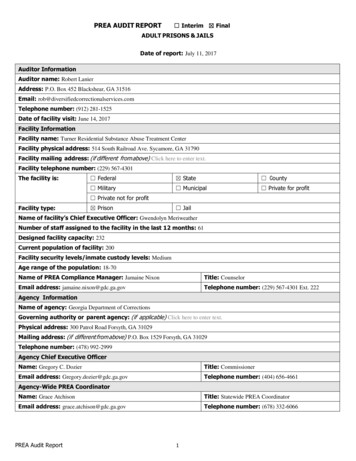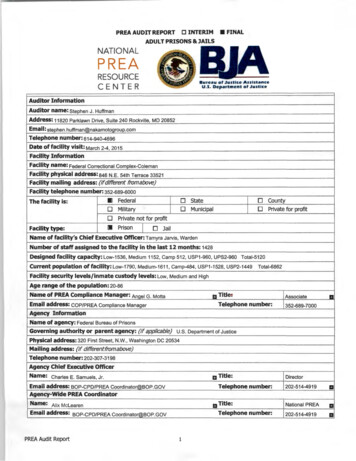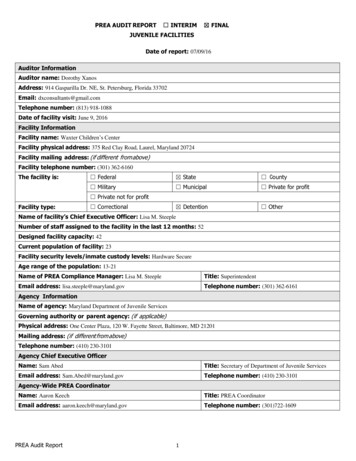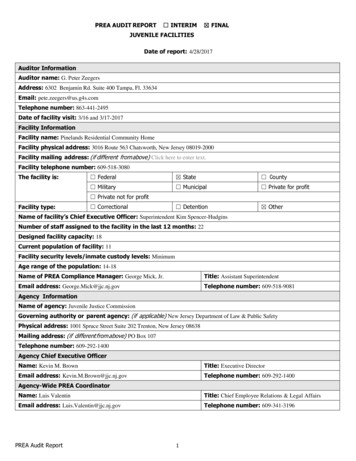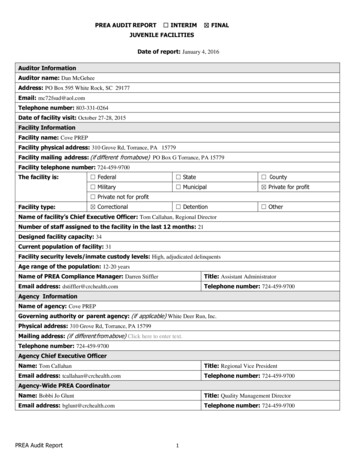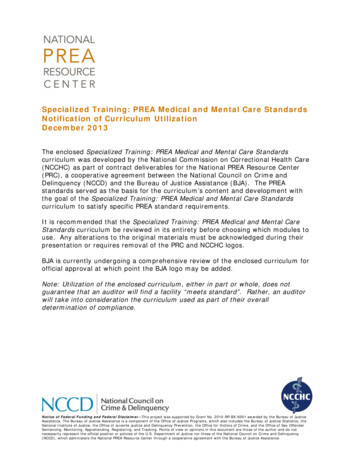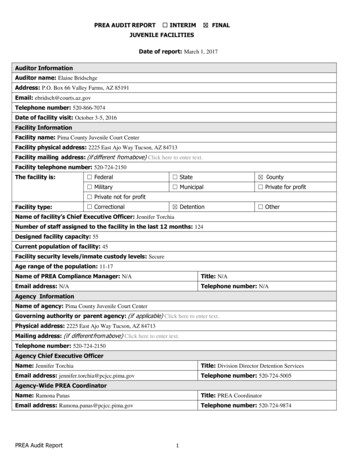
Transcription
PREA AUDIT REPORT INTERIM FINALJUVENILE FACILITIESDate of report: March 1, 2017Auditor InformationAuditor name: Elaine BridschgeAddress: P.O. Box 66 Valley Farms, AZ 85191Email: ebridsch@courts.az.govTelephone number: 520-866-7074Date of facility visit: October 3-5, 2016Facility InformationFacility name: Pima County Juvenile Court CenterFacility physical address: 2225 East Ajo Way Tucson, AZ 84713Facility mailing address: (if different from above) Click here to enter text.Facility telephone number: 520-724-2150The facility is: Federal State County Military Municipal Private for profit Detention Other Private not for profitFacility type: CorrectionalName of facility’s Chief Executive Officer: Jennifer TorchiaNumber of staff assigned to the facility in the last 12 months: 124Designed facility capacity: 55Current population of facility: 45Facility security levels/inmate custody levels: SecureAge range of the population: 11-17Name of PREA Compliance Manager: N/ATitle: N/AEmail address: N/ATelephone number: N/AAgency InformationName of agency: Pima County Juvenile Court CenterGoverning authority or parent agency: (if applicable) Click here to enter text.Physical address: 2225 East Ajo Way Tucson, AZ 84713Mailing address: (if different from above) Click here to enter text.Telephone number: 520-724-2150Agency Chief Executive OfficerName: Jennifer TorchiaTitle: Division Director Detention ServicesEmail address: jennifer.torchia@pcjcc.pima.govTelephone number: 520-724-5005Agency-Wide PREA CoordinatorName: Ramona PanasTitle: PREA CoordinatorEmail address: Ramona.panas@pcjcc.pima.govTelephone number: 520-724-9874PREA Audit Report1
AUDIT FINDINGSNARRATIVErdThe PREA onsite audit of the Pima County Juvenile Court Center (PCJCC) in Tucson Arizona was conducted on October 3 ,thth4 , and 5 , 2016 by Elaine Bridschge, from Valley Farms, Arizona, a U.S. Department of Justice Certified PREA Auditor forJuvenile Facilities. The purpose of the audit was to determine the degree of compliance with the Federal Rape Elimination Act(PREA) standards.Six weeks in advance of the onsite audit, the auditor provided the PREA Coordinator with a flyer to be posted throughout thefacility announcing the upcoming audit. The flyer explained the purpose of the audit and provided residents and staff with theauditors contact information. The Facility dated the flyer with the date when it was posted and submitted a photo to theAuditor.Pre-audit preparation included a thorough evaluation of all documentation and materials electronically submitted by the facilityalong with the data included in the pre-audit questionnaire. The documentation reviewed included agency policies,procedures, forms, education materials, training curriculum and rosters, organizational chart, posters, brochures, and otherrelevant materials that were provided to determine compliance with the PREA standards. This review prompted a series ofquestions that were submitted to the PREA Coordinator for review and clarification. Responses were submitted by the PREACoordinator in a timely manner and reviewed by the auditor prior to the onsite audit. Additional documentation was alsorequested by the auditor and submitted to the PREA Coordinator. The PREA Coordinator submitted the additionaldocumentation which was also reviewed by the auditor.rdththThe onsite portion of the audit was conducted over a three day period: October 3 , 4 , and 5 , 2016. During this time, theauditor conducted interviews with facility leadership, staff, and residents. The interviews were conducted consistent withDepartment of Justice PREA auditing expectations in content and approach utilizing the PREA Compliance Audit InstrumentInterview Guides, as well as individuals selected for interviews (i.e. Facility Director, PREA Coordinator, specialized staff,random staff, residents, etc.). The auditor was able to ask additional questions to personnel to gain more information aboutcertain practices of the facility. In addition, the auditor was able to verify through interviews specific protocols and clarifydocumentation submitted.An extensive facility tour was conducted which included observation of facility configuration, staff supervision of residents,housing, intake, classrooms, medical unit, visitation area, master control room, recreation areas, and administration areas.The auditor was able to view camera locations, showering areas, toilet facilities, and sleeping rooms. The auditor was able toinformally talk to the residents, staff, and the master control officer. While on the tour, the auditor was permitted access to allareas of the facility. Notices of the PREA audit were observed posted in each of the five housing units. The auditor wasescorted by the PREA Coordinator.Forty five residents were identified on the facility roster as being detained. The auditor was able to interview fifteen or 33% ofresidents. The residents were selected randomly by the auditor using a current roster of residents. The auditor selected aminimum of three from each of the five housing units, and a minimum of one from each gender. At the time of the onsite visit,there were no residents to interview that met the criteria for residents who reported a sexual abuse, residents in isolation,residents who disclosed prior sexual victimization during risk screening, residents who were disabled or spoke a languageother than English, or transgendered, intersex, gay, lesbian, and bisexual residents. Residents were interviewed using therecommended DOJ PREA Compliance Audit Instrument Interview Guides that question their knowledge of a variety of PREAprotections generally and specifically their knowledge of reporting mechanisms available to residents to report abuse andharassment. The auditor was able to ask additional questions to residents to gain more information about certain practices ofthe facility. In addition, the auditor was able to gather information through interviews regarding facility practices that occur inthe environment.Nineteen facility staff members were interviewed representing all three shifts (days, swings, and graves). The Auditor selectedstaff randomly and by specialty using a current staff roster. The Auditor randomly selected at a minimum: two officers pershift, one officer of each gender, one medical staff involved in cross-gender strip or visual searches, one security staff who hasacted as first responder, one intake officer, one master control officer, 2 lead officers, 2 supervisors, and one non-security staffwho had acted as a first responder. Staff were questioned using the recommended DOJ PREA Compliance Audit InstrumentInterview Guides that question their PREA training and overall knowledge of the agency’s zero tolerance policy, reportingmechanisms available to residents and staff, the response protocols when a resident alleges abuse, and first responder duties.The Auditor also interviewed specialty staff to include medical and mental health staff, intake staff, master control staff, andhuman resources and training staff. In addition, the auditor interviewed volunteers, contractors, SAFE/SANE staff, victimadvocates, intermediate or higher-level facility staff, the facility administrator/agency head, and PREA Coordinator. The facilitydoes not have a PREA compliance manager. The facility’s leadership accommodated the auditor’s request to interviewspecific staff and covered resident supervision while staff were participating in the interview process.PREA Audit Report2
While at the facility, the auditor reviewed ten resident case records, two from each housing unit which were randomly selectedby the auditor utilizing a roster of detainees provided to the auditor by the facility, to evaluate screening and intake procedures,resident education, and other general programmatic areas. The auditor also reviewed twelve employee files and 100% ofemployee training records to determine compliance with training mandates and background check procedures. All documentsreviewed by the auditor were within a one-year period from date of audit.To obtain information about the rape crisis center and advocacy services, an interview was conducted with a representativefrom the Southern Arizona Children’s Advocacy Center. Interviews were also held with a representative from the school andhealth services department.On the final day of the onsite audit, a debriefing was held with the facility’s leadership staff. The purpose of the meeting was tosummarize preliminary audit findings. During this process, specific feedback was provided and included program strengthsand areas of improvement as it relates to PREA standards.PREA Audit Report3
DESCRIPTION OF FACILITY CHARACTERISTICSThe Pima County Juvenile Court Center has a designed capacity of 55 beds, located in Tucson Arizona. All are singleoccupancy sleeping rooms. The facility consists of one single building with five housing units. Two of the five units are co-edunits, and the other three units are for male residents only. A toilet and sink is located within in each sleeping room (cell)where residents can access privately and out of view. Residents are able to change clothes in private within their assignedcell. The Pima County Juvenile Court Center houses both county and U.S. Marshal Residents ages 11 through 17. At time ofaudit, there were no U.S. Marshal residents detained. No residents older than 18 years of age are detained. The facilitysecurity level is considered as a secure facility. Residents are secured with mechanical restraints when leaving the facility.The building contains an administration area which is accessible through the master control located in main entrance. Themain entrance is controlled by the master control. Master control is staffed 24 hours per day, seven days per week. Thefacility is controlled by locking doors that is controlled by master control. The school and medical units are located within thesingle building. The school has five classrooms and a library area. The medical unit contains one medical exam room that isutilized for residents, a pharmacy, and office space. There is a minimum of one nurse assigned to the detention facility at anygiven time. Small recreation yards, with concrete floors, are adjacent to each of the five housing units. Each housing unitcontains a common day room that is used for eating meals, and programming, as well as a separate meeting room.The facility is fairly large in size and has a separate area for intake and processing. This area has a bathroom that is used forstrip searches and showering. The Superior Courthouse where residents are seen by the Judge is located within the facility.The facility implements direct podular supervision, where staff can visually supervise residents. In addition, residents are ableto move from one area to another, unescorted, and movement is monitored through master control. Programming isconducted daily by staff in the housing units. Residents have access to onsite medical and mental health services. Visitationis available daily for parents and guardians and other preapproved family members over the age of 18. Attorney visits canoccur daily.The average length of stay for a resident in The Pima County Juvenile Court Center is 24 days. At time of audit, 45 residents,36 males and 9 females, were detained. The facility currently has 124 staff employed at the facility, full-time and part-time,and two authorized contractors. Due to the Juvenile Detention Alternative Initiate (JDAI) through the Annie Casey Foundation,residents detained at any given time have been relatively low.The facility is equipped with a video monitoring system internally and externally which is monitored by a staff memberassigned to the Master Control room. Master Control personnel also control the movement of staff and residents throughoutthe facility. Meals are prepared onsite in an approved kitchen and are transported by kitchen staff to each housing unit.PREA Audit Report4
SUMMARY OF AUDIT FINDINGSIn the past 12 months, The Pima County Juvenile Court Center reported that eleven allegations of sexual abuse or sexualharassment were received. All eleven allegations were harassment related and all were unfounded. There were noadministrative investigations and no criminal investigations related to sexual abuse conducted at The Pima County JuvenileCourt Center.Overall, the interviews with residents reflected that they were aware of and understand the PREA protections and the agency’szero tolerance policy. It was unclear if all residents receive written materials at intake that provide detailed information aboutPREA protections, the multiple ways to report sexual abuse or harassment and ways to protect themselves from abuse. Allnew residents are provided with an orientation by the PREA Coordinator within seven days of intake. Residents were able toarticulate to the auditor what they would do and who they would tell if they were sexually abused. Residents consistentlyindicated to the auditor that they felt safe in the facility.All facility staff interviewed indicated that they had received detailed PREA training and could articulate the meaning of theagency’s zero tolerance policy. There is confusion among staff as to their responsibilities as a first responder for any PREArelated allegations; as well as how and who conducts investigations internally.The auditor was able to confirm that an agreement was in place with Southern Arizona Children’s Advocacy Center to providerape crisis intervention services and SAFE’s/SANE’s forensic services for victims of sexual abuse. An agreement is also inplace with the Tucson Police Department to conduct sexual abuse investigations.In summary, after reviewing all pertinent information and after conducting resident and staff interviews, the auditor found thatthe agency should devote time to staff training, policy development, risk screening tools, and third party reporting mechanisms.In discussion with facility leadership, they are very eager to begin working on the corrective action items to become in fullcompliance with PREA standards.Number of standards exceeded: 2Number of standards met: 15Number of standards not met: 21Number of standards not applicable: 3FINAL AUDIT UPDATEThe Interim Compliance Report reflected there were 21 standards that were in non-compliance at the Pima County JuvenileCourt Center. The facility was given a required correction action period not to exceed 180 days that began on November 16,2016. The auditor recommended a corrective action plan for the facility and facility staff began immediate corrections of thosestandards found to be in non-compliance. The auditor reviewed all submitted documentation to determine if full compliancewith the standards were achieved. The auditor was able to ask clarifying questions of the PREA Coordinator regarding theverification documents and requested additional documentation. The auditor provided the facility notification as standardswere met. Pima County Juvenile Court Center completed the required corrective actions requested by the auditor to bring thefacility into full compliance with the PREA standards as of the date of this final report.Number of standards exceeded: 3Number of standards met: 35Number of standards not met: 0Number of standards not applicable: 3Total Standards: 41PREA Audit Report5
Standard 115.311 Zero tolerance of sexual abuse and sexual harassment; PREA Coordinator Exceeds Standard (substantially exceeds requirement of standard) Meets Standard (substantial compliance; complies in all material ways with the standard for therelevant review period) Does Not Meet Standard (requires corrective action)Auditor discussion, including the evidence relied upon in making the compliance or non-compliancedetermination, the auditor’s analysis and reasoning, and the auditor’s conclusions. This discussionmust also include corrective action recommendations where the facility does not meet standard. Theserecommendations must be included in the Final Report, accompanied by information on specificcorrective actions taken by the facility.Facility policy A-307 PREA was developed in 2007 and updated in 2016. This policy mandates zero tolerance toward allforms of sexual abuse and sexual harassment in the Pima County Juvenile Court Center (PCJCC) facility which it directlyoperates. The policy outlines how it will implement the agency’s approach to preventing, detecting, and responding to sexualabuse and sexual harassment. It also includes a list of prohibited behaviors regarding sexual abuse and sexual harassment.The policy includes sanctions for those found to have participated in prohibited behaviors. Additionally, the policy includes adescription of agency strategies and responses to reduce and prevent sexual abuse and sexual harassment of residents.The agency employs an upper level, agency wide PREA Coordinator. The position of the PREA Coordinator is not specifiedin the organizational chart submitted by the facility. The facility submitted a job description for the Detention ProgramCoordinator. The auditor was able to verify that the Detention Program Coordinator serves as the PREA Coordinator, and isresponsible for the implementation of efforts to comply with the PREA standards. The PREA Coordinator reports directly tothe facility’s Division Director. The job description is located on the Pima County Superior Court’s website.During interview, the PREA Coordinator confirmed that she has sufficient time and authority to oversee agency efforts tocomply with the PREA standards. The facility does not operate more than one facility, therefore does not have a designatedPREA Compliance Manager.Based on the evidence discussed, the facility has demonstrated compliance with the standard.Standard 115.312 Contracting with other entities for the confinement of residents Exceeds Standard (substantially exceeds requirement of standard) Meets Standard (substantial compliance; complies in all material ways with the standard for therelevant review period) Does Not Meet Standard (requires corrective action) Not ApplicableAuditor discussion, including the evidence relied upon in making the compliance or non-compliancedetermination, the auditor’s analysis and reasoning, and the auditor’s conclusions. This discussionmust also include corrective action recommendations where the facility does not meet standard. Theserecommendations must be included in the Final Report, accompanied by information on specificcorrective actions taken by the facility.According to the Agency Contract Administrator, the facility has not entered into or renewed a contract for the confinement ofresidents on or after August 20, 2012, or since the last PREA audit, whichever is later. There are no contracts to review forthis standard.This standard is not applicable.PREA Audit Report6
Standard 115.313 Supervision and monitoring Exceeds Standard (substantially exceeds requirement of standard) Meets Standard (substantial compliance; complies in all material ways with the standard for therelevant review period) Does Not Meet Standard (requires corrective action)Auditor discussion, including the evidence relied upon in making the compliance or non-compliancedetermination, the auditor’s analysis and reasoning, and the auditor’s conclusions. This discussionmust also include corrective action recommendations where the facility does not meet standard. Theserecommendations must be included in the Final Report, accompanied by information on specificcorrective actions taken by the facility.According to facility policy A-051 Direct Supervision (updated 2016) the agency is obligated to maintain staffing ratios of aminimum of 1:8 during resident waking hours and 1:16 during resident sleeping hours.The agency submitted “Pima County Juvenile Detention Facility Staffing Plan” that contains information on the facility design,resident population, staffing positions and daily assignments, staff to youth ratios, staff supervision of residents, staff trainingand equipment, resident education and programs, and staffing plan review. The staffing plan indicates that there are twocameras placed in each living unit dayroom and one in each sally port. Detention main corridors also have cameras. Thestaffing plan review section states the plan will be reviewed whenever necessary, but no less frequency than once per year.The review process will assess and determine whether adjustments are needed to this plan for compliance with PREAstandards 115.313 (a) 1-11. The facility staffing plan indicates that the facility maintains staff ratios. No documentation ofdeviations was submitted by the facility as it reports that in the past 12 months, the number of times the facility deviated fromthe staffing ratios of 1:8 security staff during resident waking hours is zero; and during 1:16 security staff during residentsleeping hours is zero. The staffing plan specifies that the PREA Coordinator and Detention Director will review the staffingplan, staffing patterns, the deployment of monitoring technology, and the allocation of resources needed to commit to thestaffing plan to ensure compliance with the staffing plan.The facility submitted a “Staffing Plan Assessment” form that is used to review staffing patterns, policies, procedures, facilitymonitoring systems, and other monitoring technologies in use. According to the PREA Coordinator, this is a newly developedform (created August 2016). The first annual review will be in August 2017, and every August thereafter. Due to this processbeing new, there were no additional annual assessments to review.The welfare/cell check form that was submitted for lead staff to document unannounced rounds is insufficient as it reflectslead staff monitoring 15-minute cell checks once per month, but not welfare checks of every resident on a regular basis. Noother documentation was available for review.During interview, the Superintendent stated that the agency formalized the staffing plan this year (2016) and will be reviewingit annually. The Superintendent stated that when assessing adequate staffing levels and the need for video monitoring, thefacility staffing plan will consider: local and state standards, PREA standards, school activity, and staffing patterns. Inaddition, shift reports will be used to check for compliance with the staffing plan. The Superintendent stated that supervisorssend an email out to management to document when the facility is unable to meet the requirements of the staffing plan. TheSuperintendent stated that the agency utilizes intermittent, on-call juvenile detention officers in order to meet the staffing planand remain in compliance with ratio. An on-call list is maintained and managed by detention administration. TheSuperintendent also stated that the agency is obligated by Arizona Office of the Courts (AOC) to maintain staffing ratios. Thiswas verified by reviewing the AOC detention standards.According to the PREA Coordinator, the facility does not have a policy addressing how to conduct PREA unannouncedrounds and that lead staff conduct unannounced rounds of residents. The PREA Coordinator reports that since August 20,2012, or the last PREA audit, whichever is later, the average daily number of residents is 24 and the average daily number ofresidents on which the staffing plan was predicated is 24.The current facility population is 45 which is inconsistent with the average daily attendance of 24 that was reported by thePREA Coordinator. As the staffing plan is in its early implementation phase, it is recommended that the facility re-assess thestaffing plan a minimum of every 12 months and re-evaluate as needed.PREA Audit Report7
Interviews with three lead staff detected that unannounced rounds are not documented. As well, lead staff does notunderstand the reasoning behind conducting such rounds. The PREA Coordinator stated that lead staff conductunannounced rounds, however during interview with the three lead staff, there tends to be confusion between verifying that15-minute cell checks are completed and conducting PREA unannounced rounds. Lead staff also stated that they onlycomplete such rounds once per month and that they do not account for each resident when doing so.Based on the evidence discussed, the facility has not demonstrated compliance with this standard due to the need for stafftraining and a written procedure for conducting unannounced rounds, and this auditor has recommended the followingcorrective action items to be completed within six months.CORRECTIVE ACTION NEEDED:1. The facility will provide staff training on how to conduct announced rounds, the purpose of unannounced rounds, andhow to document rounds. This will be verified by submitting a training agenda and sign in roster to the auditor.2. The facility will develop a procedure and form to document the ongoing occurrence of unannounced rounds. Thefacility will submit to the auditor a written procedure, tracking form, and a 30-day sampling of unannounced roundsbeing conducted on each shift daily.VERIFICATION OF CORRECTION ACTION:The Auditor was provided appropriate supplemental documentation on December 20, 2016 to evidence and demonstratecorrective actions taken regarding this standard.Additional Documentation Reviewed: A sign in roster was submitted to the auditor as verification that seven supervisors received training on “UnannouncedRounds”. The roster was dated October 6, 2016 and November 10, 2016. Agenda items were submitted to include protocol of conducting and documenting unannounced rounds. Protocolstates that rounds will be conducted one time per shift to ensure constant compliance. The protocol states that staffwill ensure that all residents are accounted for and that unannounced rounds are documented. A sampling of “PREA Unannounced Rounds Log” were submitted to the auditor for review. The logs were datedbetween November 11, 2016 and December 16, 2016. The logs documented the shift, time, any issues or commentsand staff signature of all unannounced rounds conducted. Distribution of completed logs are notated on the form andare to be turned in to the PREA Coordinator when sheet is completed.Based on the evidence discussed, the facility has demonstrated compliance with the standard.Standard 115.315 Limits to cross-gender viewing and searches Exceeds Standard (substantially exceeds requirement of standard) Meets Standard (substantial compliance; complies in all material ways with the standard for therelevant review period) Does Not Meet Standard (requires corrective action)Auditor discussion, including the evidence relied upon in making the compliance or non-compliancedetermination, the auditor’s analysis and reasoning, and the auditor’s conclusions. This discussionmust also include corrective action recommendations where the facility does not meet standard. Theserecommendations must be included in the Final Report, accompanied by information on specificcorrective actions taken by the facility.Facility policy C-201 Youth and Facility Searches state all searches, excluding the unit, room, and wand searches, shall beconducted by personnel of the same sex as the youth being searched. This policy requires that all cross-gender stripsearches, cross-gender visual body cavity searches, and cross-gender pat down searches be documented on a strip searchauthorization form and verified by a juvenile detention supervisor or designee. No documentation of cross-gender searches isavailable.Facility policy A-051 Direct Supervision that enables residents to shower, perform bodily functions, and change clothingwithout non-medical staff of the opposite gender viewing their breasts, buttocks, or genitalia.PREA Audit Report8
Facility policy A-307 PREA prohibits staff from searching or physically examining a transgender or intersex resident for thesole purpose of determining the residents genital status. Staff stated that they are aware of the facility’s policy that prohibitsstaff from searching or physically examining a transgender or intersex resident for the sole purpose of determining theresidents genital status. At time of audit, the facility did not have any transgender residents to interview.There are no logs of cross gender pat down searches to review.During the tour of the facility, the auditor observed that there were three resident showers in each housing unit. All showersare single use only. Resident showers have doors concealing residents from observers. Only a residents head and feet canbe observed. There are two cells located directly across from the showers in the two co-ed (male/female) units. The celldoors have windows and the cells were occupied by residents. Staff report that residents are to remain seated on their bedswhen other residents are showering to avoid having a visual of those in the shower.During random staff interviews, all staff stated that they are restricted from conducting cross-gender strip or visual body cavitysearches and that it must be an exigent circumstance and approved by the Detention Director, and only as a last resort thatwould warrant such a search. During interview with random staff, all staff stated that residents are oriented about the bellsystem.All fifteen residents interviewed, reported that staff of the opposite gender of them has not performed a pat down search oftheir body. During interviews with fifteen residents, one stated that he did not know what the bell was for. Fourteen residentswere able to explain to the auditor the purpose and intent of the bell system.According to the PREA Coordinator, the facility does not have a policy that addresses requiring staff of the opposite gender toannounce their presence when entering a resident housing unit or area where residents are likely to be showering, performingbodily functions, or changing clothes. The facility has implemented a bell system that alerts residents of inc
PREA Audit Report 1 PREA AUDIT REPORT INTERIM FINAL JUVENILE FACILITIES Date of report: March 1, 2017 Auditor Information Auditor name: Elaine Bridschge Address: P.O. Box 66 Valley Farms, AZ 85191 Email: ebridsch@courts.az.gov Telephone number: 520-866-7074 Date of facility visit: October 3-5, 2016 Facility Information
